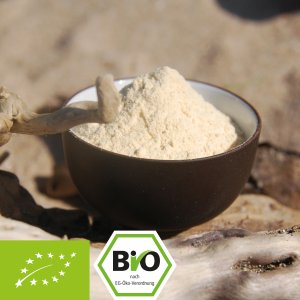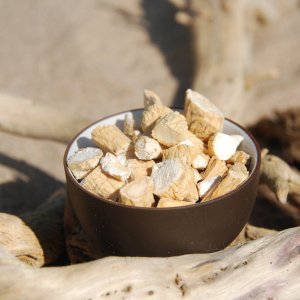Ginseng - A traditional root - But does it live up to expectations?
To find out, we take a closer look at the ginseng root in this article.
What is ginseng?
Ginseng is an herbaceous plant from the ivy family that originally comes from East Asia. Ginseng translates as 'remedy'. Its root has medicinal benefits for humans and in Chinese and Korean medicine, the araliaceae plant has been used as a remedy for several thousand years; this is documented in documents dating back to around 40 BC.
Ginseng has also been known in Europe since the 17th century and is becoming increasingly popular.
The power root is said to activate the body and mind and promote concentration.
There are two types of ginseng, red and white. However, there is only one basic difference: after harvesting, red ginseng is steamed at around 100 °C for 3-5 hours, which gives it its red color, and then dried; white ginseng, on the other hand, is dried directly.
Historical facts about ginseng:
Ginseng has been used as an adaptogen for more than 5000 years. Adaptogens are active plant substances that help the organism to adapt to increased emotional and physical stress situations and to compensate for particular stimuli. Around 40 years BC, ginseng was already regarded as a means of ensuring a healthy and long life and was therefore reserved for nobles, kings and emperors. For them, the plant had a higher value than silver and gold. Ginseng collectors were only allowed to keep one root themselves, all others had to be given to the court. Citizens even faced the death penalty if they did not comply.
Around 2000 years ago, Emperor Shi Huang Ti planned expeditions to Korea to enrich himself with the valuable ginseng plant, as ginseng was supposed to protect the throne from conspiracies and evil.
Although the plant has been known as a remedy for several thousand years, it only found its way to Europe 300-400 years ago. Since then, however, it has become increasingly popular and its medicinal benefits have been investigated in various studies. You can find more information on this in the "Studies" chapter.
Cultivation, harvesting and processing of ginseng root:
Ginseng cultivation is very time-consuming. The seed takes two years to germinate and the care of the plant is very intensive. A Korean proverb says: "The ginseng constantly wants to hear the farmer's footsteps." This should make it clear what effort goes into growing it.
After harvesting, the soil needs about ten years of rest before new ginseng can be planted in the ground, as it contains too few nutrients before the ten years are up and the young plant would die prematurely. Potassium-rich soil at an altitude of 400 - 700 meters is best suited for cultivation.
Temperatures between 20 and 25 °C in summer and between 1 and 14 °C in winter are ideal. Even small amounts of snow cannot harm the plant.
Ginseng is planted in autumn and must be protected from excessive sunlight, as wild ginseng only grows in shady places in the forest. Ginseng farmers often use straw mats for protection. A small amount of sunlight is essential for growth, but if there is too much or no light at all, the plant will die. The ginseng plant grows up to 80 cm high and has palmate leaves on the stem.
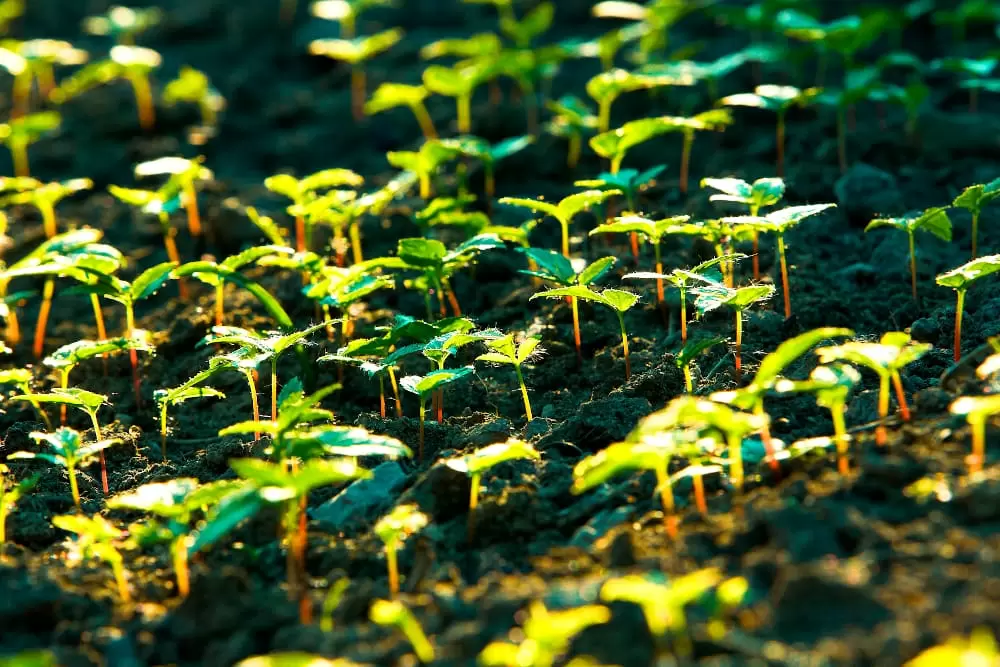
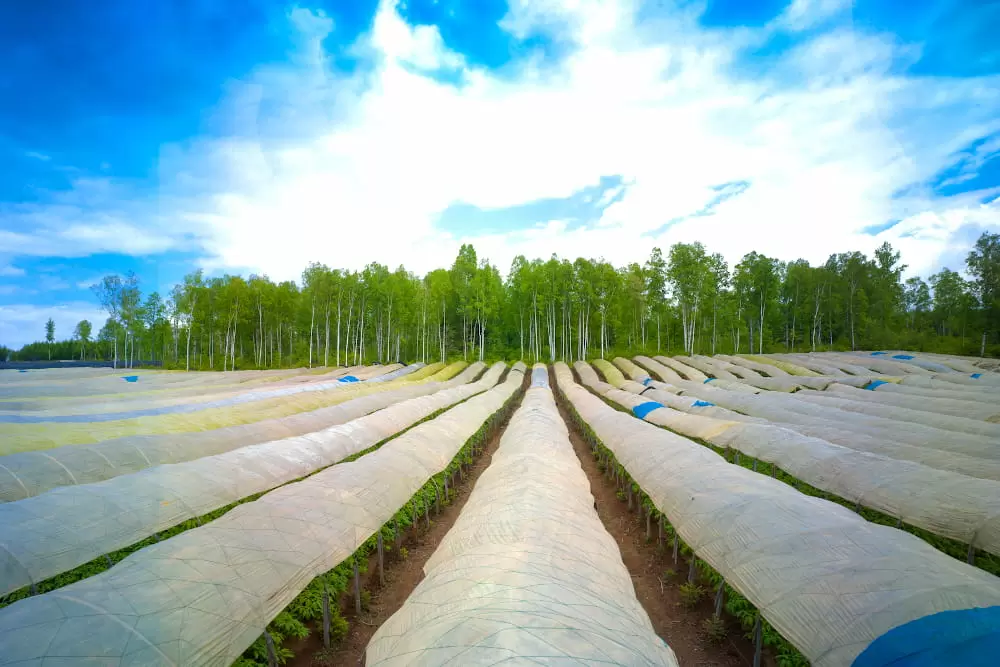
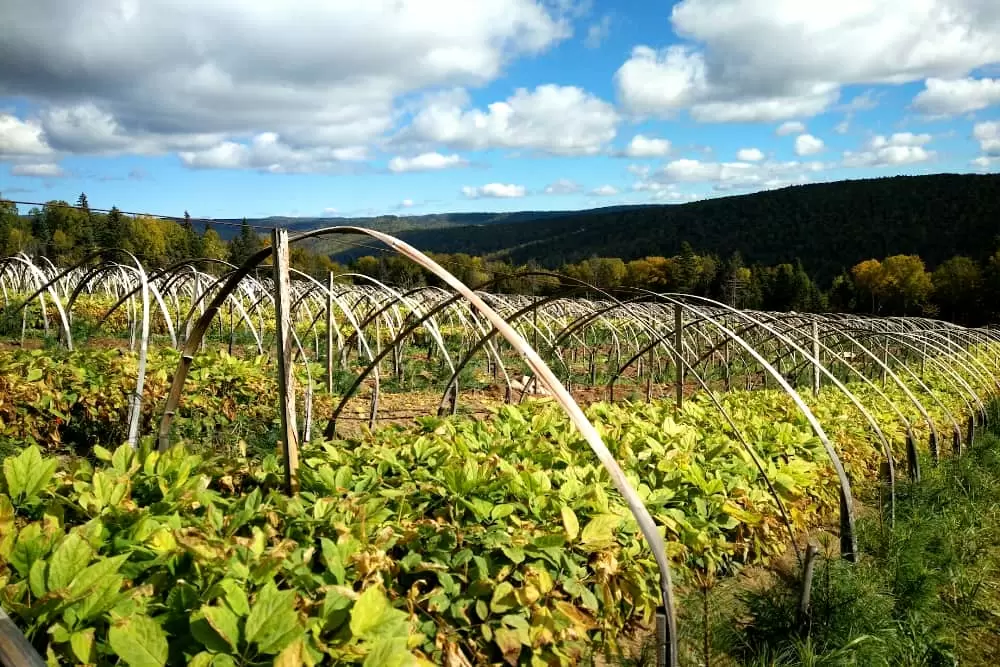
Care should also be taken to ensure proper watering; avoid waterlogging and dry periods at all costs.
The red or yellow-white flowers of the plant carry the seeds for the next sowing. These seeds are surrounded by pulp, which must be removed before sowing. The cylindrical root forms numerous secondary branches and the inside of the root is cream-colored. The valuable roots can be harvested four years after germination. In total, it takes around six years to harvest; premature harvesting can result in a considerable reduction in quality. However, farmers have now learned a few tricks to speed up the ripening process and shorten it by two years. Firstly, the seeds are soaked in damp sand before sowing. This makes the shell break open more easily and germination takes place earlier. The soil is also replaced to avoid the ten-year dormancy period. However, whether this affects the quality of the ginseng root is controversial.
After harvesting, the roots are cleaned with clear water and prepared for drying. Ginseng root has a water content of more than 70 %. Drying in ovens or freeze dryers therefore prevents the valuable power root from spoiling.
The dried root is then processed into powder or extract, but often also simply into cubes or slices.
Ginseng - dosage form and use:
Ginseng root has a very high water content, which is why the root spoils quickly after harvesting. It is therefore usually offered in dried form. However, there are completely different dosage forms: Powder, capsules, (chewable) tablets, granules, tea, tonic (schnapps) or in its natural form. However, the most common type is probably ginseng powder and the dried root.
Ginseng smells of horseradish, sometimes also of liquorice, and initially tastes bitter, but then develops a sweetish taste.
The root can be used in various ways and used in cooking. Ginseng is particularly suitable as a seasoning for salads or vegetables. The root is also very popular as a tea. The powder or dried root can be crushed and poured over boiling water and left to infuse for a few minutes.
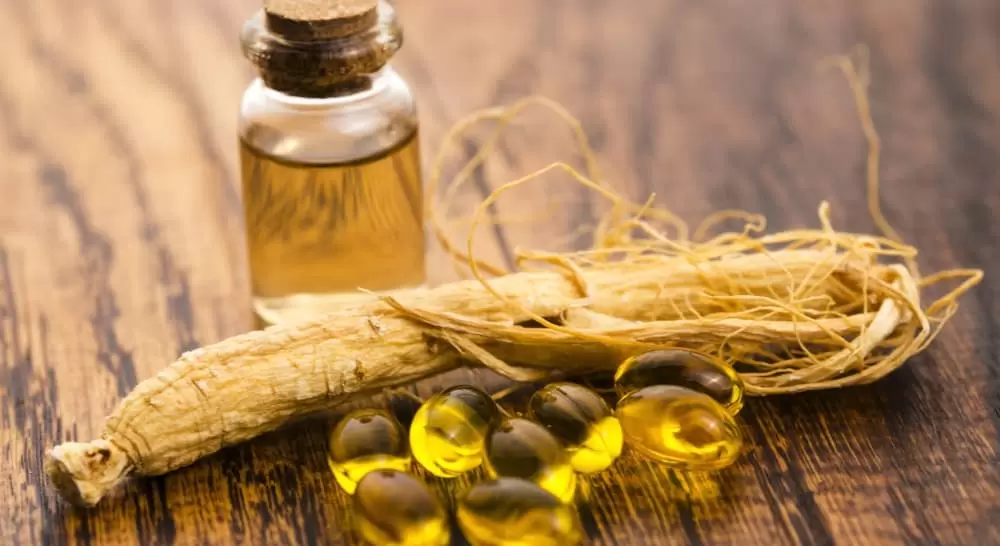
What ingredients are found in ginseng and how do they work?
The ginseng plant contains many different substances, the most important of which are the ginsenosides. You can read more about this in the following chapter.
In addition to ginsenosides, minerals and trace elements, essential oils and vitamins have also been identified. Essential fatty acids and amino acids are also present and contribute to a real nutrient bomb. 'Essential' means that the body cannot produce these substances itself, or cannot produce them completely, and we must therefore obtain them from food. Amino acids are the building blocks of proteins and are therefore essential for the muscles.
Important minerals such as zinc and iron are also vital and are contained in ginseng in non-negligible quantities.
Ginsenosides - the weapons of the ginseng root:
Ginsenosides are saponins from the ginseng root. They are also known as panaxosides and are used by the plant as a passive defense against fungi and insect pests.
There are three groups of panaxosides:
- Panaxdiols
- Panaxtriols
- Oleanolic acids
Further link to ginsenosides >>>
The therapeutic potential of ginseng has been intensively studied. The ginsenosides it contains are the active components of the ginseng root and are said to be involved in many physiological processes and their optimization. Ginsenosides bind to nerve-typical receptors and as they are very similar in composition to the body's own substances, their effect is based on the "lock-and-key principle". Around 30 ginsenosides have now been identified. The composition and quality of the ginsenosides is influenced by various factors, such as the age of the plant, the species and the harvest time.
Studies show that ginseng, or rather the ginsenosides, can promote the body's own defense against stress. The immune system is also said to be strengthened; this is also attributed to the ginsenosides.
People can therefore use the ginsenosides for their own health. They not only promote stress resistance, but can also regulate blood pressure, metabolism and the immune system.
Every year - the Ginseng Festival:
For more than thirty years, the Geumsan Ginseng Festival has been held annually at harvest time in Chungcheongnam-do, a province in South Korea. Here, the benefits and healing effects that ginseng has to offer are presented and emphasized.
The majority of ginseng plants from South Korea are cultivated and processed in Chungcheongnam-do. However, the market for other medicinal herbs is also one of the largest in the country.
The Ginseng Festival offers a wide variety of programs related to the power root; there are seminars on the healing properties of ginseng, a pavilion where various ginseng products are offered, as well as several fairs for the international ginseng trade. Traditional folk games, singing and dance performances are also events worth seeing. There is even a cooking competition and a quiz at the popular festival. And most importantly, the region's ginseng farmers proudly present their harvest after six years. There is no age limit for this festival, so people of all ages can come together and have fun.
You can find a short video overview of the festival below. Unfortunately, the video is only available in English.
Studies on the effects of ginseng:
Asthmatic diseases:
A large part of the research is taking place in the field of asthmatic diseases. Although current therapeutic measures are effective and help to reduce airway inflammation, they do not prevent the structural changes in mucosal tissue that the disease causes in the long term.
This study aims to determine the effectiveness of ginseng (administered orally) in laboratory mice with chronic asthma. For this purpose, a precisely defined amount of ginseng was administered orally to laboratory mice over a certain period of time.
Link to the study: https://www.ncbi.nlm.nih.gov/pubmed/18611306
The mice were divided into four groups: Ginseng, placebo, control group and dexamethasone, an anti-inflammatory agent that has a dampening effect on the immune system. For proper evaluation, the pathologically altered lung tissue was examined using light and electron microscopes.
Compared with the placebo group, the mice given ginseng showed a reduction in structural airway changes.
However, this study has not yet been carried out on the human organism, which is why it is not possible to guarantee that these results are 100% transferable to humans. Nevertheless, this scientific finding is an enormous step forward in asthma therapy and encourages further research.
Ginseng and mental performance:
A study by the Human Cognitive Neuroscience Unit at the University of Newcastle was able to prove that even a single intake of ginseng can increase mental performance.
Link to the study: https://www.ncbi.nlm.nih.gov/pubmed/12020739
Twenty students were given a defined amount of ginseng, gingko, a combination preparation or a placebo over a certain period of time. Memory tests were then carried out. The results showed not only increased memory performance, but also mental speed.
Another study by this research institution, in which the thirty test subjects were each given 200 mg of ginseng, also demonstrated an improvement in cognitive abilities.
Link to the study: https://www.ncbi.nlm.nih.gov/pubmed/15982990
Mental fatigue was also significantly reduced, which is attributed to the regulation of blood sugar levels.
Researchers investigated this effect in another study and were able to prove that ginseng can lower glucose levels in the blood and thus also have a positive effect on diabetes.
Link to the study: https://www.ncbi.nlm.nih.gov/pubmed/25265315
Ginseng is also said to be a miracle cure for stress. Stress is caused by the release of adrenaline and noradrenaline, as well as the release of cortisol. Normally, this bodily reaction is regulated, but if this regulatory ability is disrupted, the body is permanently in a stress reaction, which can ultimately lead to chronic stress. Here, ginseng provides the necessary balance and supports the human organism in better adapting to harmful stimuli and influences (noxae).
Further link >>>>
Take-home massage:
The studies shown here support and reinforce each other's results. In summary, it can therefore be said that ginseng can possibly promote concentration and make us more resistant to stress. The second point in particular is very important and is therefore the focus of further research, as chronic stress makes people ill. Nowadays, however, it is unfortunately completely normal for stress to accompany us throughout the day. We usually rush through rush hour traffic before we even get to work and arrive at work already annoyed by gridlocked traffic and traffic jams. Here, too, people are often stressed because constant pressure to perform and competitiveness often demand more than we can achieve. After a stressful day at work, once again stuck in rush-hour traffic, we still can't switch off and when we finally get home, it's often too late to give our bodies enough time to rest and relax.
Enjoying a ginseng tea can help us to react more calmly to all these influences and reduce stress, even if only to a small extent.
